Check out my custom vibration dampener
7 Best Lightweight Tennis Shoes
Men’s & Women’s 2024 Guide
We hope you love this article. Just so you know, TennisCompanion may collect a small share of sales from the links on this page to help keep this site running. Learn more.
The lighter your tennis shoes, the faster you can move, so it’s no surprise that a shoe’s weight has become one of the most highly sought-after features when buying a new pair.
Technological advancements have enabled companies to make lighter shoes without sacrificing too much in other areas, including stability, durability, and comfort. Still, most players will find there’s a tradeoff.
In this guide, I’ll review the pros and cons of weight and its impact on a shoe’s performance, along with sharing my picks for the best lightweight tennis shoes for men and women.
Here are my top 3 picks for men and women as a preview.
Men
Women
Click here to check out the full list of shoes that make the cut.
Article Contents
Click below to jump to a section
Tap below to jump to a section
Lightweight Shoe Trend
Inexpensive Lightweight Shoes
Tennis Shoe Weight Ranges
Lightweight Advantages
Lightweight Disadvantages
7 Best Lightweight Shoes
New to TennisCompanion?
Create a free account and explore my latest videos below
Lightweight Tennis Shoe Trend

In recent years, top tennis shoe brands have continued to push the boundaries by offering lighter footwear while maintaining the stability required to perform and keep players safe.
A few factors contribute to this trend, but player demand and technology advancements are perhaps the most prominent.
Player Demand
Historically, one of the more significant complaints tennis players have had about their shoes is the weight, which used to be necessary to provide sufficient stability, durability, and comfort.
However, as the game has become more aggressive and faster-paced, so has the demand of players looking to shed weight to help them move as quickly as possible on the court while enhancing movement during lengthy matches, pushing manufacturers to innovate.
Technological Advancements
The challenge has always been to shed weight without sacrificing other vital attributes, including durability, stability, and comfort.
However, the industry has seen significant improvements in lightweight tennis shoes through advancements in materials and design.
Asics Flytefoam midsoles are a great example of lightweight shoe design. According to Asics lab tests, Flytefoam is 55% lighter than traditional EVA midsoles while providing 76% better cushioning.
In the Babolat line, you’ll find the Jet Mach III with its Matryx EVO upper that uses high-performance Aramid, a.k.a. Kevlar, and Polyamide fibers to produce a durable and stable offering without the extra bulk.
That means excellent performance with less weight to help players move more quickly around the court regardless of age and level.
Inexpensive Lightweight Shoes
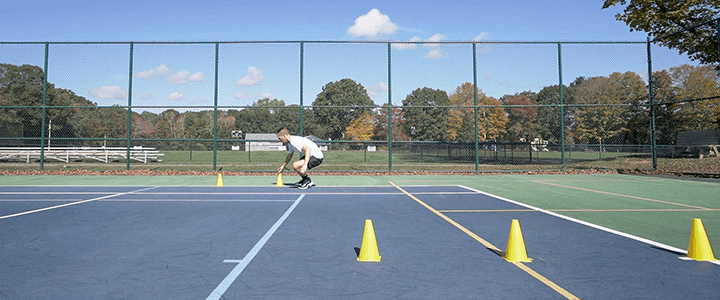
Contrary to what some players might think, many of the lightest tennis shoes on the market are the least expensive.
That’s because inexpensive tennis shoes tend to shed some of the features higher-end shoes offer for added durability and stability. The result is tennis shoes that might not meet the most advanced tennis players’ demands but are lightweight.
For this reason, some of the higher-end tennis shoes aren’t always the lightest. Regardless, you’ll still find some of the higher-priced options emphasize low weight, especially compared to other premium options.
As you evaluate new tennis shoes, keep in mind that you’ll likely have to make some tradeoffs regarding the weight of your shoes. However, if you’re learning to play tennis, some less expensive shoes might be excellent lightweight options.
Tennis Shoe Weight Ranges

Let’s compare a handful of the most popular to help provide some context around the weight of various tennis shoes.
Although this list isn’t exhaustive for every tennis shoe on the market, they’re some of the most popular as a point of reference.
Of the shoes I’ve included, men’s tennis footwear weighs between 11.9 and 15.6 ounces (337 – 442 grams) in size 10.5, while women’s shoes fall between 10.0 and 13.5 ounces (284 – 383 grams) in size 8.5. Please note that these weights are for one single shoe, not a pair.
Although you may not wear a men’s 10.5 or a women’s 8.5, the relative weight comparing one to another will provide you with a helpful basis for comparison.
Men’s
| Shoe | Men’s @ 10.5 |
| Wilson Kaos Swift | 11.9 oz |
| Babolat Jet Mach III | 12.1 oz |
| Babolat Jet Tere | 12.4 oz |
| adidas adizero Club 2 | 12.6 oz |
| Asics Solution Speed FF 2 | 12.9 oz |
| New Balance 996v5 | 12.9 oz |
| K-Swiss Hypercourt Express 2 | 13.0 oz |
| K-Swiss Hypercourt Supreme | 13.1 oz |
| adidas adizero Ubersonic 4.1 | 13.4 oz |
| adidas SoleMatch Control | 13.8 oz |
| Wilson Rush Pro 4.0 | 13.9 oz |
| adidas adizero Cybersonic | 14.1 oz |
| Nike Vapor Pro 2 | 14.3 oz |
| New Balance Fresh Foam Lav v2 | 14.3 oz |
| Babolat Propulse Fury | 14.4 oz |
| adidas Barricade 13 | 14.8 oz |
| Asics Gel Resolution 9 | 14.8 oz |
| Asics Court FF 3 | 15.3 oz |
| K-Swiss Ultrashot 3 | 15.3 oz |
| Nike Zoom Vapor 11 | 15.5 oz |
| Nike Air Zoom Vapor Cage | 15.6 oz |
| Nike Air Zoom GP Challenge | 15.6 oz |
Women’s
| Shoe | Women’s @ 8.5 |
| Wilson Kaos Swift | 10.0 oz |
| Babolat Jet Tere | 10.0 oz |
| Babolat Jet Mach III | 10.2 oz |
| adidas adizero Club 2 | 10.4 oz |
| adidas adizero Ubersonic 4.1 | 10.5 oz |
| Asics Solution Speed FF 2 | 10.6 oz |
| New Balance 996v5 | 10.8 oz |
| K-Swiss Hypercourt Express 2 | 10.8 oz |
| K-Swiss Hypercourt Supreme | 10.8 oz |
| adidas SoleMatch Control | 10.8 oz |
| New Balance Fresh Foam Lav | 11.4 oz |
| Wilson Rush Pro 4.0 | 11.8 oz |
| Nike Vapor Pro 2 | 12.3 oz |
| K-Swiss Ultrashot 3 | 12.3 oz |
| adidas Barricade | 12.5 oz |
| Nike Zoom NXT | 12.6 oz |
| Nike Air Zoom GP Challenge | 12.6 oz |
| Asics Gel Resolution 9 | 12.7 oz |
| Babolat Propulse Fury | 12.8 oz |
| Nike Zoom Vapor 11 | 12.9 oz |
| Asics Court FF 3 | 12.9 oz |
| Nike Air Zoom GP Turbo | 13.5 oz |
Unfortunately, the order of weights differs slightly for the women’s models of the above shoes, so they don’t perfectly line up from lightest to heavier.
Regardless, these tables should provide a solid snapshot of what to expect from the weight of tennis shoes across various brands.
Lightweight Advantages
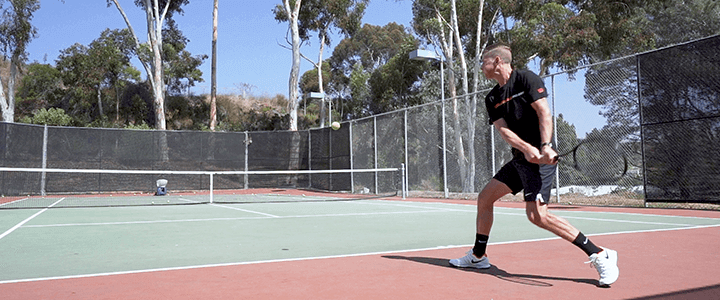
For some players, lightweight tennis shoes are a must. Here are a few reasons to consider this type of shoe yourself.
Speed
The main advantage of lightweight tennis shoes is that there’s less weight holding your feet down, which means you can move around the court faster.
You’ll also find that some lightweight models feature modified designs to improve the heel-to-toe transition required to move quickly.
Whether taking an explosive first step or scrambling to retrieve a ball, a lightweight tennis shoe can give you that slight edge that enables you to return more balls to your opponent.
Ventilation
Although it’s not necessarily true across the board, most lightweight tennis shoes tend to have breathable mesh uppers that provide terrific ventilation to help keep a player’s feet feeling fresh.
If you play in hot climates or have trouble keeping your feet dry, ventilation is another reason to consider a lightweight pair of shoes.
Stamina
Tennis can be grueling, and although you might feel fresh early on in a match, keeping your feet moving in the later stages often makes or breaks a player’s success on the court.
Although the slight differences of a few ounces might not seem like a lot, it can begin to impact a player’s movement when their legs start feeling heavy in a third-set tiebreaker.
The lighter your shoes, the easier it will be to stay on your toes when you’re feeling the fatigue of a hard-fought match.
Mental Edge
Even if lightweight tennis shoes have a negligible effect on a player’s movement, their fast and agile feeling can translate to confidence and better overall performance.
There’s no doubt tennis is as much a mental game as physical.
Lightweight Disadvantages
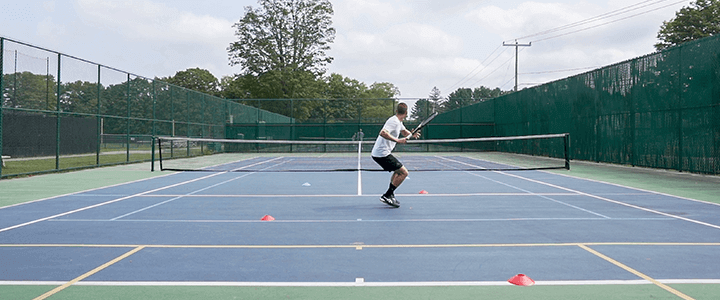
Despite many improvements in lightweight footwear for tennis, there are still drawbacks worth considering, often stemming from a reduction in the material.
Here are some of the top complaints that tend to bubble up. As you review these, keep in mind that I’m discussing these disadvantages relative to the performance of the best shoes with a bit more weight, so it doesn’t necessarily mean lightweight shoes are awful in these areas.
Durability
One area where lightweight tennis shoes tend to suffer the most is durability. To keep the weight of footwear down, companies will reduce the amount of protective material available.
The outsole, or the dense, durable, and heavy rubber at the bottom of a shoe, tends to be part where less material helps reduce weight but results in players wearing down their shoes faster.
Similarly, many tennis shoes provide protective materials that wrap or cover a shoe’s upper to resist abrasion. These materials are minimized or dropped entirely to decrease weight in some cases.
The net result is that a shoe’s durability tends to decline as the shoe’s weight decreases.
For this reason, you’ll typically find that many of the lightest tennis shoes don’t have durability guarantees.
Helpful Tip
Although durability may not always be the strong suit for many lightweight tennis shoes, if you go with an affordable pair that costs less, you may be able to justify purchasing shoes more regularly.In some cases, you’ll be able to purchase two inexpensive shoes that are lighter in weight for less than the cost of a premium offering.
Stability
Adding extra material to a shoe’s sole and upper can help increase its overall stability. Therefore, as companies reduce the material throughout the shoe, they lose a bit in this department.
Creative shoe design has enabled less material to provide adequate stability, but most players agree that the most stable shoes typically aren’t the lightest.
Comfort
Most of a shoe’s comfort will stem from the midsole, usually a lightweight EVA foam. However, to an extent, if the thickness of a midsole decreases, so does the comfort and shock absorption.
Some shoes will reduce EVA foam or replace it with alternative technologies, such as a Nike Zoom Air unit, to reduce weight, but many contend it doesn’t provide the same comfort level.
Compared to other disadvantages, this is where technological advancements have allowed lightweight tennis shoes to be as comfortable as any other, but it ultimately depends on the shoe.
7 Best Lightweight Tennis Shoes for Men & Women
Let’s look at my favorite picks for the best lightweight tennis shoes for men and women, starting with the reigning champion for the lightest.
I’ve included a table of my favorite picks below for a quick comparison of each shoe’s weight based on a men’s size 10.5 and a women’s size 8.5.
To qualify for this list, each shoe had to equal or fall below 14.5 ounces on the men’s side. For women’s shoes, I set the mark at 12.5 ounces.
Lightest: Babolat Jet Mach III

One of the lightest-weight tennis shoes currently available for men and women is the Babolat Jet Mach II, which weighs an impressive 12.1 ounces for a men’s size 10.5 and only 10.2 ounces for a women’s size 7.5. The third generation of the shoe is a few grams heavier than the second generation, but it still clocks in the lowest weight overall.
This shoe features Micheline DIN20 rubber for the outsole, the same advanced material you’ll find on car tires, which provides the excellent traction and durability you’d expect for your vehicle.
The Jet Mach III offers an updated Kompressor midsole, also known as KPRS-X, which provides lightweight comfort and helps ensure improved shock absorption when a player strikes the ground heel first with more cushion toward the back of the shoe.
The shoes also keep things lightweight with Babolat’s Matryx EVO upper, which weaves Kevlar and Polyamide fibers into strategic areas to provide maximum durability and stabilization, dubbed Stability Cage.
If you’re looking for another exceptionally lightweight option in the Babolat family of shoes, check out the Babolat Jet Tere. They weigh 12.4 ounces for a men’s size 10.5 and 10 ounces for a women’s size 8.5.
Specs
| Size | Short |
| Width | Narrow |
| Arch Support | Medium |
| Men’s Weight | 12.1 ounces @ size 10.5 |
| Women’s Weight | 10.2 ounces @ size 8.5 |
Asics Solution Speed FF 2
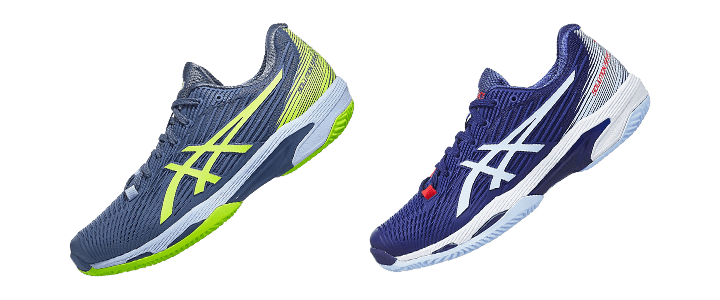
The Asics Solution Speed FF is one of my picks for the best tennis shoes in 2022, and they’re also one of the lightest men’s and women’s tennis shoes available.
The shoe’s outsole takes advantage of Asics’ High Abrasion Rubber, also known as AHAR, which splits into two pieces separated by a Trusstic stabilization system – one at the forefoot and another at the heel – to deliver traction and durability.
The rubber wraps higher at the toe of the shoe to form the toe guard to increase protection in this high-wear area.
The midsole for this model shoe uses FlytFoam, one of its significant upgrades from its predecessor, which is 55% lighter and delivers 76% better cushioning than conventional EVA foam. The result is the most lightweight midsole that Asics has ever produced.
The Asics Solution Speed FF’s upper delivers form-fitting comfort through its FlexionFit technology and wraps the outermost layer with abrasion-resistant polyurethane for added protection.
Specs
| Size | True |
| Width | Medium |
| Arch Support | Medium |
| Men’s Weight | 12.9 ounces @ size 10.5 |
| Women’s Weight | 10.6 ounces @ size 8.5 |
adidas adizero Ubersonic 4.1
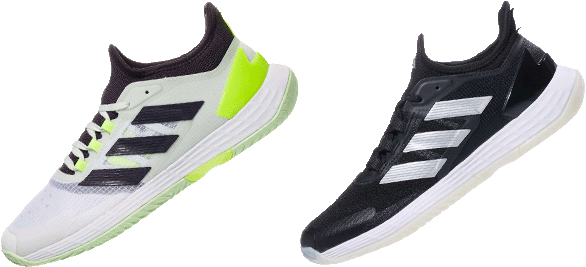
The Adizero Ubersonic 4.1 is a high-performance tennis shoe from adidas offering lightweight comfort in a premium package.
For the shoe’s outsole, you’ll find Adiwear rubber for impressive traction on a wide range of surfaces and the same technology used across most tennis shoes from adidas.
At the midsole, you’ll find an EVA midsole adidas called Lightstrike for lightweight comfort and maximum shock absorption.
The upper is where the Ubersonic 4.1 saves a fair bit of weight, featuring a Primeknit sock-like bootie construction combined with their Primegreen material for extra stability and an outer layer of Adituff for protection against abrasion.
Specs
| Size | True |
| Width | Medium |
| Arch Support | Slightly low |
| Men’s Weight | 13.4 ounces @ size 10.5 |
| Women’s Weight | 10.5 ounces @ size 8.5 |
New Balance 996v5
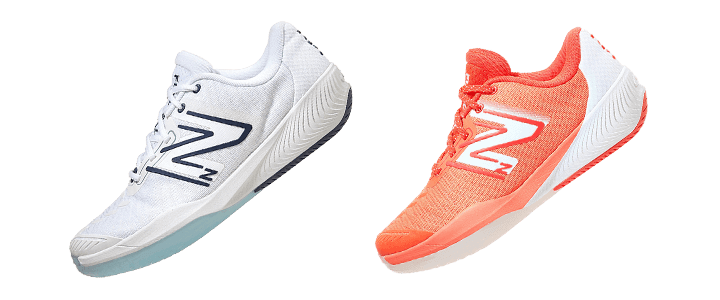
If you’re looking for a lightweight tennis shoe from the New Balance lineup, the 996v5 will be the shoe to check out.
This shoe features New Balance’s NDurance rubber compound for the outsole to provide maximum durability and traction. However, to cut down on weight, they’ve also incorporated their Lightweight Solid Rubber (LWSR) into areas of low wear.
At the shoe’s midsole, you’ll find FuelCell foam throughout the entire length of the shoe. This unique EVA foam helps increase energy return to the player as they push off while maintaining torsional stability through the shoe’s center with a mid-foot shank.
The upper for the 996v5 is all about lightweight design and uses NDure, which is lightweight and stable. A simple toe cap at the front of the shoe’s upper helps provide extra abrasion resistance for foot drags.
As a bonus, you’ll find some retailers offering a six-month outsole durability guarantee with this shoe, a significant benefit for anyone considering a lightweight offering.
Specs
| Size | True |
| Width | Medium |
| Arch Support | Slightly low |
| Men’s Weight | 12.9 ounces @ size 10.5 |
| Women’s Weight | 10.8 ounces @ size 8.5 |
K-Swiss Hypercourt Supreme
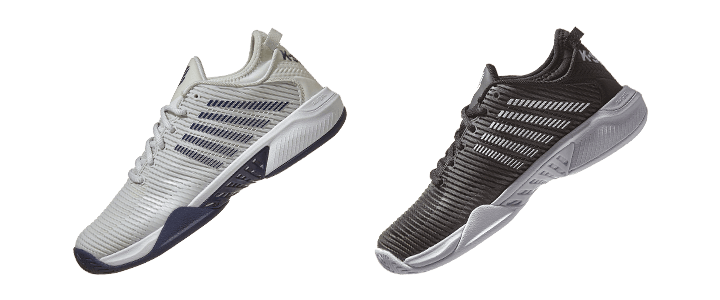
One of the lightest-weight offerings from K-Swiss, the Hypercourt Supreme offers excellent all-around performance.
K-Swiss uses their Aösta 7 high-density rubber for the outsole to give players durability and traction.
The Hypercourt Supreme takes advantage of K-Swiss’ Surge 7.0 to provide lightweight cushioning throughout the midsole and incorporates a mid-foot shank to help cut down on twisting, which increases the shoe’s stability.
Finally, the shoe’s upper offers plenty of ventilation, as is common with lightweight tennis footwear. However, the shoe doesn’t skimp on durability by covering it with its DuraWrap Flex technology, which also helps improve its stability.
Add to that a molded bootie construction for maximum comfort and support, and the K-Swiss Hypercourt Supreme is a worthy contender for the best lightweight tennis shoe.
Specs
| Size | True |
| Width | Slightly wide |
| Arch Support | Medium |
| Men’s Weight | 13.1 ounces @ size 10.5 |
| Women’s Weight | 10.8 ounces @ size 8.5 |
Nike Vapor Pro 2
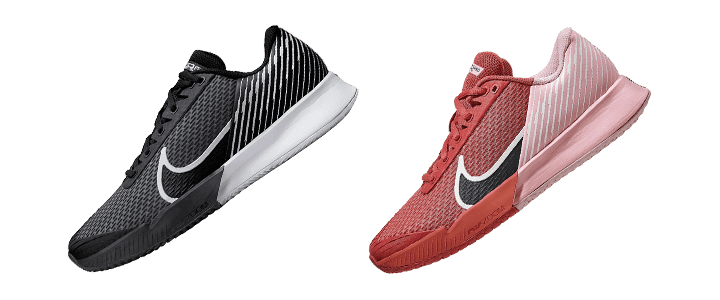
One of my favorite shoes, the Nike Air Zoom Vapor Pro, an evolution of the Vapor X, is the heaviest of my lightweight selection but is an excellent all-around package that provides one of the best performance blends. Plus, it comes in a hard and clay court model.
The outsole of the Vapor Pro 2 is one of the unique areas where the shoe cuts down weight. Instead of using a consistent thickness throughout the shoe’s length, Nike has reduced unnecessary rubber in areas where their research suggests wear is less.
At the midsole, the shoe combines an EVA midsole with a Zoom Air package at the shoe’s forefoot to absorb shock and shed weight while providing responsive comfort that’s low to the ground. Nike improves stability with a full-length foot frame at the shoe’s outside edge.
At the top of the Vapor Pro, you’ll find an ultra-breathable mesh that’s lightweight for maximum comfort, combined with a flexible internal sleeve that hugs your foot for extra support.
At the same time, an asymmetrical lacing system offers a snug fit to help keep your foot secure during sharp movements.
Specs
| Size | True |
| Width | Medium |
| Arch Support | Medium |
| Men’s Weight | 14.3 ounces @ size 10.5 |
| Women’s Weight | 12.3 ounces @ size 8.5 |
Wilson Rush Pro 4.0 
Wilson has been making inroads into tennis footwear and apparel for the past few years. The Rush Pro 4.0 is the latest evolution of Wilson’s flagship offering that’s light yet performant in other areas.
Wilson uses high-density Duralast rubber for the outsole, which provides top-notch traction and surprising durability for its weight. Plus, it’s the only shoe on this list where you can find an outsole durability guarantee.
The Rush Pro’s midsole uses R-DST+ for responsive comfort, while the 4D supporting foot frame and TPU plate or shank help prevent twisting for confident movement.
Finally, the upper uses Wilson’s SensiFeel 2.0 mesh for lightweight ventilation, while the shoe’s Endofit sock-like construction enhances comfort and aids stability.
Specs
| Size | True |
| Width | Slightly wide |
| Arch Support | Slightly low |
| Men’s Weight | 14.9 ounces @ size 10.5 |
| Women’s Weight | 11.8 ounces @ size 8.5 |
Wrapping Up
Nowadays, more lightweight tennis shoes deliver better overall performance than ever with technological improvements.
Although you’ll be making concessions in the durability and stability of your shoes in some instances, it’s a reasonable tradeoff that many players are willing to make for the extra speed they get around the court.
If you take the plunge into the lightweight shoes on offer, keep in mind that you’ll likely need to replace yours more frequently.
Are you wearing lightweight tennis shoes? In the comments below, let me know which model you’re using, and, of course, feel free to post any questions you might have about lightweight shoes below.
Play Better Tennis
Improve your game alongside our community of tennis players
Why join?
Discussion Boards
Join the conversation with other members of the community.
5 Point Friday
Read our weekly recap of the 5 most interesting things we dig up in tennis.
Leave a Reply
Want to join the discussion?Feel free to contribute!

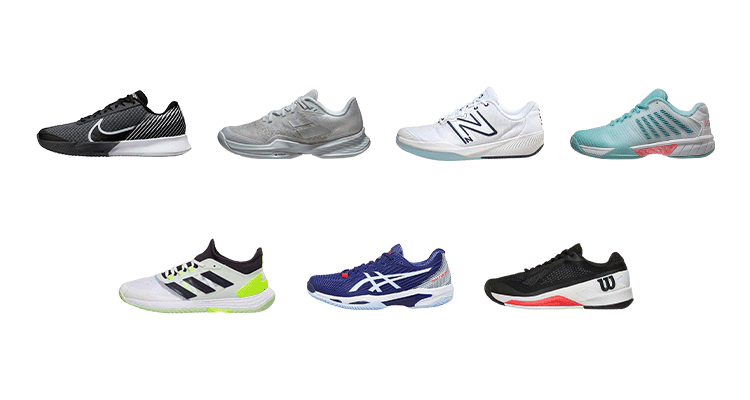

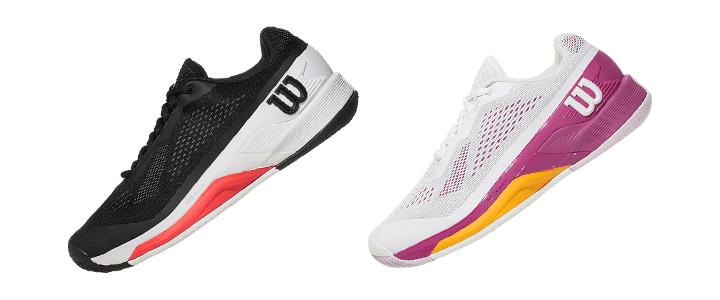
When you refer to the weight of various shoes, is it the weight for one shoe or for both shoes?
Hi Frank,
Fantastic question! The weight I refer to for shoes in this article is the weight of one shoe, size 10.5 for mens and 8.5 for women’s. Thank you for taking the time to ask.
All the best,
Jon
You are missing the ligtest tennis shoe you can buy which in my research it seems to be:
wilson Kaos Swift 1.5
at 324 g in size 10 according to tennis warehouse europe
Hi Lassen,
Thanks for the note! I’ve included the Wilson Kaos in this article’s ‘Weight Ranges’ section, but they’re not part of my official picks of the best because other shoes performed better.
It’s worth noting that the shoes I pick aren’t necessarily the lightest. Instead, they’re what I view to offer the best lightweight performance. In other words, this guide showcases the best of available lightweight tennis shoes. Unfortunately, just because a shoe is the lightest doesn’t mean it qualifies as the best in that category.
I hope that helps, and thanks again for taking the time to share.
All the best,
Jon